Agamemnon › Trojan War » Ancient origins
Articles and Definitions › Contents
- Agamemnon › Who Was
- Trojan War › Antique Origins
Ancient civilizations › Historical and archaeological sites
Agamemnon › Who Was
Definition and Origins
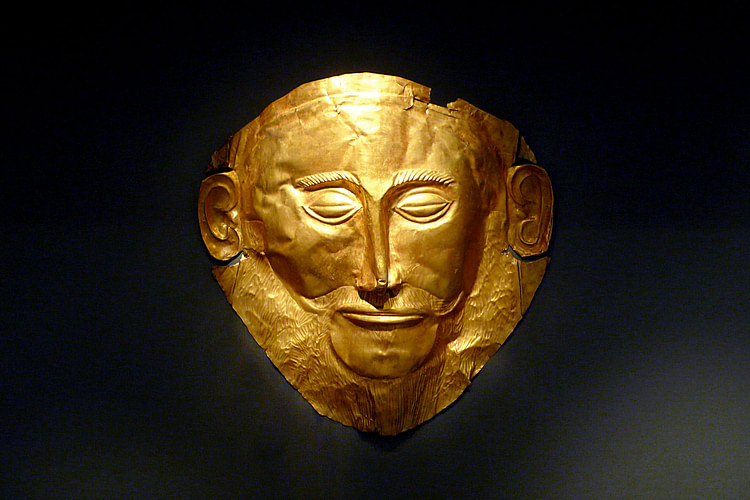
Agamemnon was the King of Mycenae and leader of the Greek army in the Trojan War of Homer ’s Iliad. He is presented as a great warrior but selfish ruler, famously upsetting his invincible champion Achilles and so prolonging the war and suffering of his men. A hero from Greek mythology, there are no historical records of a Mycenaean king of that name, but the city was a prosperous one in the Bronze Age and there perhaps was a real, albeit much shorter, Greek-led attack on Troy.Both these propositions are supported by archaeological evidence. Unfortunately though, the famous gold mask found in a shaft grave at Mycenae and widely known as the 'Mask of Agamemnon' is dated as up to 400 years before any possible Agamemnon candidate that fits a chronology of the Trojan War.
FAMILY
Agamemnon was the son of Atreus, or perhaps grandson, in which case his father was Pleisthenes. His mother was Aerope, from Crete which provided a handy link between the Mycenaean civilization of the Greek Peloponnese and the earlier Minoan civilization of Bronze Age Crete. He was married to Clytemnestra with whom he had three daughters. In one version these are Chrysothemis, Laodice and Iphianassa while in other, later versions they are Chrysothemis, Elektra and Iphigeneia.Agamemnon was the brother of Menelaos, king of Sparta.
MYCENAE
According to Homer, Agamemnon was given his king's sceptre and right to rule Mycenae and all the Achaean Greeks by Zeushimself. Agamemnon is described as a great warrior and so as a worthy leader of men. According to Plato, his name derives from menein meaning 'to endure'. Mycenae, located 15 km from the sea in the northern Peloponnese, then prospered and Homer describes the city as a 'well-founded citadel', as 'wide-wayed', and as 'golden Mycenae'. This mythological prosperity is supported by the excavation of over 15 kg of gold objects recovered from the shaft graves in the fortified acropolis which still dominates the plain today. Further excavations have also revealed that the city once covered 30,000 m² and was first inhabited in Neolithic times.
THE TROJAN WAR – THE BEGINNING
Our main source of information on the Trojan War is Homer's epic mythological account in the Iliad, written in the 8th century BCE but almost certainly based on a much older oral tradition. The ancient Greeks themselves considered the conflict to have been a real one and taken place in the 13th century BCE. The story came to represent the struggle of Greeks against foreign powers and it told tales of a time when men were better, more able, and more honourable. After Homer, the Trojan War became a staple theme in Classical Greek and Roman literature and was revisited many times by writers in works such as Aeschylus ' Agamemnon, Euripides ' Trojan Women, and Virgil ’s Aeneid. Later authors, especially Aeschylus, altered parts of the story, probably for dramatic effect on an audience all-too-familiar with it. Scenes from the conflict were also a favourite with visual artists for the next millennium.
AGAMEMNON FORMED A COALITION ARMY OF GREEK STATES AND SAILED IN A HUGE FLEET ACROSS THE 'WINE-DARK SEA' TO TROY.
The War began when Paris, a Trojan prince, abducted Helen, wife of Menelaos, from Argos. Paris regarded her as his rightful reward for choosing Aphrodite as the most beautiful goddess in a competition with Athena and Hera at the wedding of Peleus and Thetis. A furious Menelaos then appealed to his brother Agamemnon to create a coalition force of Greek warriors and rescue Helen from Troy. This Agamemnon did, and the force from such cities as Athens, Sparta, Corinth, Rhodes and just about everywhere else across Greece sailed in a huge fleet across the 'wine-dark sea' to Anatolia.
Well, they would have done, if Agamemnon hadn't upset the goddess Artemis when he killed one of her sacred stags and then boasted he was a better hunter than the goddess, herself famous for her hunting skills. As punishment, Artemis becalmed the Greek fleet and only the sacrifice of Iphigeneia would appease the goddess into granting a fair wind to Troy. Agamemnon duly offered his daughter in sacrifice but in pity and at the last moment, the goddess substituted a deer for the girl and made Iphigeneia a priestess at her sanctuary at Tauris. In Aeschylus' version Agamemnon ruthlessly sacrifices his daughter, then still a child, and so guarantees his wife's eternal hatred and his own murder later on in the story.
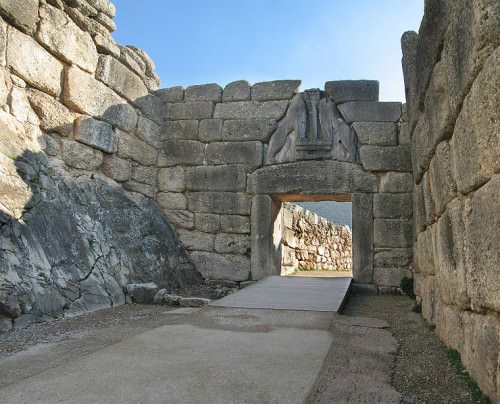
Lion's Gate at Mycenae
AGAMEMNON UPSETS ACHILLES
Finally arriving at Troy, most of the next nine years was spent in the Greeks laying siege to the well-fortified city. Indecisive skirmishes ensued but, as the Iliad tells, the time was near for the decisive moments of the war. As Agamemnon roused his men thus,
Let every man of you prepare well for the fighting – put a good edge on your spears, and a good hang to your shields, give a good feed to your swift-footed horses, and cast a good eye over your chariots, so that we can run the trial of hateful Ares all day long. ( Iliad, Book 2, 380-384)
However, after another inconclusive clash, things finally got more interesting with a couple of one-on-one battles, first between Menelaos and Paris, and then Ajax against Paris' brother Hektor. Neither dual ended in a fatality. More skirmishes followed and in these Agamemnon excelled:
As when annihilating fire falls on a thick forest scrub, and the wind carries it billowing all over, and the bushes are brought down headlong in the flames' overwhelming onslaught, so the fleeing Trojans went down under Agamemnon, son of Atreus, and many strong-necked horses rattled empty chariots along the avenues of battle, missing the noble charioteers they knew: but they lay dead on the ground, a sight now to gladden vultures, not their wives. ( Iliad, Book 11, 155-162)
Despite his prowess, Agamemnon was stabbed in the arm by Koon who paid for his strike with his head, and the king retired to his camp. The next big event was when the Trojans attacked the Greek camp and set fire to their ships. Things were not going at all well for the Greeks, and Agamemnon was largely to blame for he had upset the Greek's greatest fighter Achilles when he pulled rank and stole the hero's female war-booty Briseis. As a result, Achilles went into a sulk and refused to fight.Agamemnon sent Odysseus to persuade Achilles to rejoin the fighting on the promise of tremendous treasure. Achilles refused, and it was only when his great friend Patroklos was killed by Hektor that he put on his armour and helped the Greeks regain the initiative in the war by killing Hektor. The war still rumbled on, though, and it was only Odysseus' ruse of the Wooden Horse, which allowed the Greeks to get inside the city, which finally brought the fall of Troy.

Trojan Horse
RETURN HOME & DEATH
When Agamemnon returned to Mycenae in glory and with his prize, Trojan King Priam's daughter, Cassandra, he was, alas, killed by his jealous wife Clytemnestra and her lover Aegisthus while he was enjoying his coming-home banquet. In later versions of the story Clytemnestra killed her husband in the bath with a knife. However Agamemnon died, his fate was said to be a just punishment from the gods for outrageously demanding he share the spoils from Troy only 50/50 with the gods. In the dynastic squabbles so frequent in Greek tragedy Orestes, eight years after the event and inspired by Apollo, took revenge on his mother for her part in Agamemnon's murder. Orestes was then in turn tormented by the winged Furies, the spirits of punishment. Agamemnon is not quite finished with Greek mythology, though, as he does pop up again when Odysseus travels to Hades in Homer's Odyssey. The dead king explains to Odysseus his downfall,
Poseidon did not wreck my ships with fearful squalls and tempestuous winds, nor did I fall to any hostile tribe on land. It was Aegisthus who plotted my destruction and with my accursed wife put me to death. He invited me to the palace, he feasted me, and he killed me as a man fells an ox at its manger. That was my most pitiful end. ( Odyssey, Book 11, 406-413)
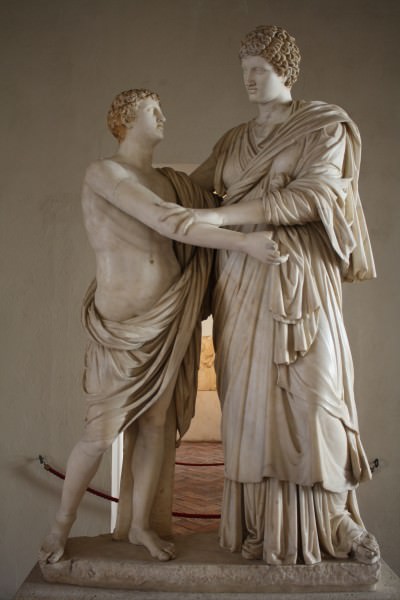 ORESTES & ELECTRA
ORESTES & ELECTRA

THE TROJAN WAR IN ARCHAEOLOGY
A conflict between Mycenaeans and Hittites in Anatolia may well have occurred in the late Bronze Age and archaeological excavations at Troy have revealed that Troy VI (c. 1750-1300 BCE), one of many layers in the site's history, is the most likely candidate for the besieged city of Homer's Trojan War. Impressive fortification walls, which are 5 m thick and 8 m high and include several towers, certainly fit the Homeric description of 'strong-built Troy'. The lower town covers an impressive 270,000 m² protected by an encircling rock-cut ditch and suggests a grand city like the Troy of tradition.
Troy VI was also partially destroyed, with evidence of fire and, intriguingly, bronze arrowheads, spear tips, and slingshots have been found embedded in the fortification walls, strongly suggesting some sort of conflict. The dates of these (c. 1250 BCE) and the site destruction correlate with Herodotus ' dates for the Trojan War. It is extremely unlikely that Homer's 10 year-conflict really occurred but the myth may well have been based on smaller, more repeated conflicts between the Mycenaeans and Hittites as they battled for control of lucrative trade routes in the Aegean.
THE MASK & TOMB OF AGAMEMNON
The so-called 'Death mask of Agamemnon', which is a beaten gold funeral mask from Grave Circle A, at Mycenae dates to the mid-16th century BCE. The mask, one of five in fact, therefore, predates Agamemnon by 400 years but nevertheless remains solid evidence of Homer's description of Mycenae as 'rich in gold'. The attribution to Agamemnon was first suggested by Heinrich Schliemann who excavated both Troy and Mycenae in the 18th century CE. The mask was laid upon the face of the deceased and some scholars suggest it is an early attempt at portraiture in European art. The mask is on permanent display at the National Archaeological Museum of Athens.
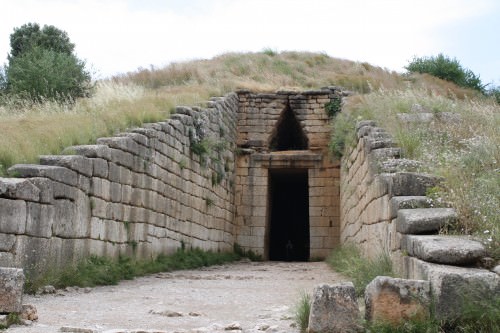
Treasury of Atreus, Mycenae
Just outside the acropolis of Mycenae is the celebrated tholos tomb, known as the Treasury of Atreus. It is a monumental circular building with corbelled roof reaching a height of 13.5 m and is 14.6 m in diameter. It is approached by a long walled and unroofed corridor 36 m long and 6 m wide. Lacking any written or pictorial evidence and dating from the 14th century BCE it is, once again, too early to be connected with the mythical Agamemnon. Interestingly, cults of Agamemnon did arise in later centuries after the Mycenaeans had long since disappeared, especially at Mycenae where his tomb was thought to lay but also at Chaeronea, Klazomenai, Tarentum, and in Laconian where it was also claimed lay the tomb of this great mythical king who had ruled Greece in the age of heroes.
Trojan War › Antique Origins
Definition and Origins
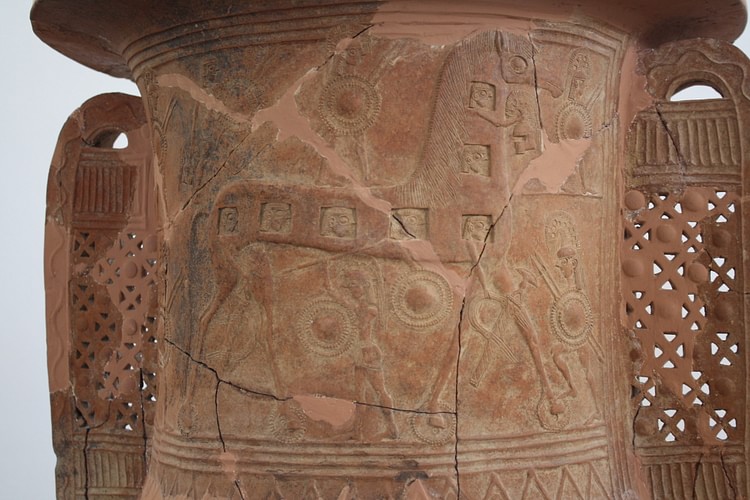
The Trojan War, fought between Greeks and the defenders of the city of Troy in Anatolia sometime in the late Bronze Age, has grabbed the imagination for millennia. A conflict between Mycenaeans and Hittites may well have occurred, but its representation in epic literature such as Homer ’s Iliad is almost certainly more myth than reality. Nevertheless, it has defined and shaped the way ancient Greek culture has been viewed right up to the 21st century CE. The story of gods and heroic warriors is perhaps one of the richest single surviving sources from antiquity and offers insights into the warfare, religion, customs, and attitudes of the ancient Greeks.
PARIS & HELEN
The main source for our knowledge of the Trojan War is Homer's Iliad (written sometime in the 8th century BCE) where he recounts 52 days during the final year of the ten-year conflict. The Greeks imagined the war to have occurred some time in the 13th century BCE. However, the war was also the subject of a long oral tradition prior to Homer's work, and this, combined with other sources such as the fragmentary Epic Cycle poems, give us a more complete picture of what exactly the Greeks thought of as the Trojan War.
The Trojan War, in Greek tradition, started as a way for Zeus to reduce the ever-increasing population of humanity and, more practically, as an expedition to reclaim Helen, wife of Menelaos, King of Sparta and brother of Agamemnon. Helen was abducted by the Trojan prince Paris (also known as Alexandros) and taken as his prize for choosing Aphrodite as the most beautiful goddess in a competition with Athena and Hera at the wedding of Peleus and Thetis. Menelaos and the Greeks wanted her back and to avenge Trojan impudence.
THE GREEK ARMY
The coalition of Greek forces (or Archaians as Homer often calls them) was led by King Agamemnon of Mycenae. Amongst the cities or regions represented were Boiotia, Phocia, Euboea, Athens, Argos, Corinth, Arcadia, Sparta, Kephalonia, Crete, Rhodes, Magnesia, and the Cyclades. Just how many men these totalled is unclear. Homer states an army of 'tens of thousands' or rather more poetically 'as many [men] as the leaves and flowers that come in springtime'.
THE GODS HAD THEIR FAVOURITES AMONGST THE MEN FIGHTING DOWN ON THE PLAINS OF TROY & THEY OFTEN PROTECTED THEM BY DEFLECTING SPEARS.
Amongst the Greek warriors were some extra special heroes, leaders who were the greatest fighters and displayed the greatest courage on the battlefield. Also, they often had a divine mother or father whilst the other parent was a mortal, thereby creating a genealogical link between the gods and ordinary men. Amongst the most important were Achilles, Odysseus, Ajax, Diomedes, Patroklos, Antilokus, Menestheus, and Idomenus.
The Greeks were aided by several of the Olympian gods of Greek religion. Athena, Poseidon, Hera, Hephaistos, Hermes, and Thetis all gave direct or indirect help to the Greeks in Homer's account of the war. The gods had their favourites amongst the men fighting down on the plains of Troy and they often protected them by deflecting spears and even spiriting them away in the heat of battle to put them down somewhere safe, far from danger.
THE TROJAN ARMY
The Trojan army defending the great city of Troy, led by their king Priam, had assistance from a long list of allies. These included the Carians, Halizones, Kaukones, Kikones, Lycians, Maionians, Mysians, Paionians, Paphlagonians, Pelasgians, Phrygians, and Thracians.
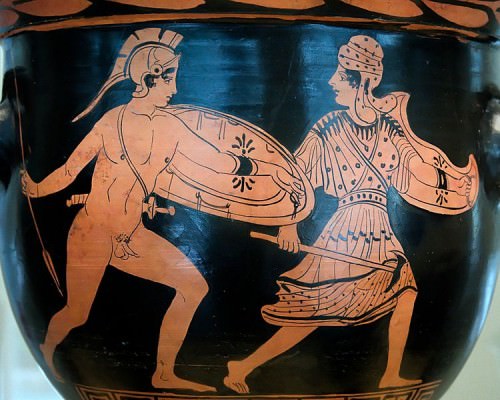
Achilles & Penthesileia
The Trojans, too, had their semi-divine heroes and these included Hektor (son of Priam), Aeneas, Sarpedon, Glaukos, Phorkys, Poulydamas, and Rhesos. The Trojans also had help from the gods, receiving assistance during the battle from Apollo, Aphrodite, Ares, and Leto.
KEY BATTLES
Most of the Trojan War was in a fact a protracted siege, and the city was able to resist the invaders for so long principally because its fortifications were so magnificent. Indeed, in Greek mythology, the walls of Troy were said to have been built by Poseidon and Apollo who, after an act of impiety, were compelled by Zeus to serve the Trojan King Laomedon for one year.There were, though, battles outside the city where armies fought, sometimes with chariots, but mostly by men on foot using spears and swords and protected by a shield, helmet, and armour for the chest and legs. War waged back and forth across the plains of Troy over the years, but the really exciting battles seem to have been reserved for the final year of the siege and the following are a selection of the highlights.
PARIS V MENELAOS
Tiring of indecisive battles, Menelaos offered to fight Paris in single-combat and so settle the issue of the war. Agreeing to this, the two warriors drew lots to see who would have first throw with their spear. Paris won and threw first but his spear landed harmlessly in the shield of Menelaos. The Greek king then threw his weapon with tremendous force and the spear went through the shield of Paris and carried on through to pierce his armour. If Paris had not swayed at the last moment, he would surely have been killed outright. However, Menelaos was not finished and with his sword he struck a fearful blow on the Trojan prince's helmet. The sword shattered, though, and fell in pieces into the dust. Menelaos then grabbed Paris' helmet with his bare hands and proceeded to drag him from the field. Choking as his helmet strap wrapped around his neck, Paris was only saved through the intervention of Aphrodite who broke the helmet strap and, covering the prince in a thick mist, spirited her favourite back to the safety of his perfumed bedroom.
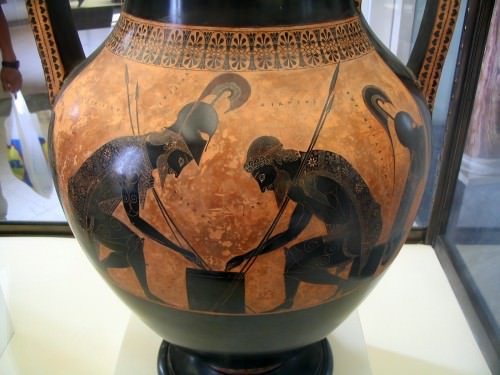
Achilles and Ajax By Exekias
HEKTOR V AJAX
The meeting of the two great heroes echoes that of Menelaos and Paris. Each throw their spears but to no effect. Hektor then threw a large rock at the Greek, only for him to fend it off with his shield. Ajax then returned the favour with an even bigger rock, smashing Hektor's shield. They then drew their swords and closed for mortal combat but were each stopped by their comrades who called for an end to the fighting as night was approaching. Displaying the code of honour for which the good old days were famous, the two warriors even said goodbye on friendly terms by exchanging gifts, Hektor giving a silver -hilted sword and Ajax giving a splendid purple belt.
WITH THE SUPPORT OF APOLLO, AN INSPIRATIONAL HEKTOR, IN HIS FINEST HOUR, ONCE MORE BEAT THE GREEKS BACK TO THEIR SHIPS.
THE GREEK SHIPS ATTACKED
Following a tremendous day of fighting, Hektor led the Trojans in an attack on the very walls of the Greeks' camp. Breaking through the gates, the Trojans sent the Greeks fleeing in panic back to their ships. However, as Zeus was momentarily distracted by the charms of Hera, Poseidon stepped in to encourage the Greeks who rallied and forced the Trojans to retreat.Then the tide of battle changed again and, with the support of Apollo, an inspirational Hektor, in his finest hour, once more beat the Greeks back to their ships where he sought to set them ablaze.
PATROKLOS FALLS
Invincible Achilles was quite simply the greatest warrior in Greece, or anywhere else for that matter. Much to the Greek's frustration, though, he sat out most of the war in a big sulk. Agamemnon had stolen his female war-booty Briseis and consequently the hero refused to fight. Agamemnon at first doesn't seem to have been too bothered about losing his temperamental talisman but as the Trojans started to gain an upper hand in the war, it began to look like Achilles would be needed if the Archaians were to actually win the protracted conflict. Accordingly, an increasingly desperate Agamemnon sent an appeal to Achilles with promises of vast treasure if he would only re-join the conflict. These Achilles refused but with the Greek camp under attack, Patroklos appealed to his mentor and great friend Achilles to rejoin the conflict and, when he still refused, Patroklos asked for permission to wear Achilles' armour and lead the fearful Myrmidons himself. Achilles, on seeing one of the Greek ships already ablaze, reluctantly gave his consent but warned Patroklos to only repel the Trojans from the camp and not pursue them to the walls of Troy.
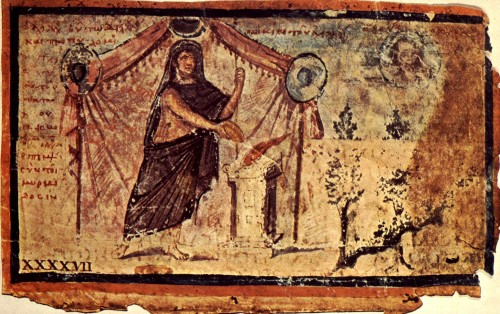
Ambrosian Iliad
ACHILLES' NEW ARMOUR
When Achilles discovered the death of his great friend Patroklos, he was overcome with grief and rage and he swore to take terrible revenge on the Trojans and Hektor in particular. After a suitable show of mourning, Achilles finally decided to enter the battlefield once more. It was a decision which would seal the fate of Troy.
RESPLENDENT IN HIS SHINING ARMOUR, ACHILLES, STILL MAD WITH RAGE, PREDICTABLY ROUTED THE TROJANS.
Before he could enter the fighting, though, Achilles needed new armour and this was provided by his divine mother Thetis who had Hephaistos, the master craftsman of Olympus, make him the most magnificent set of armour ever seen. Using bronze, tin, silver, and gold, the god made a massive shield which depicted a myriad of earthly scenes and all the constellations. So too, he made a dazzling, gold-crested helmet for the hero. Resplendent in his shining armour, Achilles, still mad with rage, predictably routed the Trojans who fled in panic behind the safety of their city walls.
HEKTOR V ACHILLES
Hektor alone remained standing outside the walls but at the sight of the awesome Achilles on the rampage, even his nerve gave way and he made a run for safety. Achilles, however, gave chase and pursued the Trojan prince three times around the city walls. Finally catching him, Achilles killed his quarry with a vicious stab of his spear in Hektor's throat. Achilles then stripped the body of its fine armour and, tying Hektor by the ankles to his chariot, Achilles dragged the body back to the Greek camp in full view of Priam standing atop the fortifications of the city. This was a shockingly dishonourable act and against all the rules of ancient warfare.
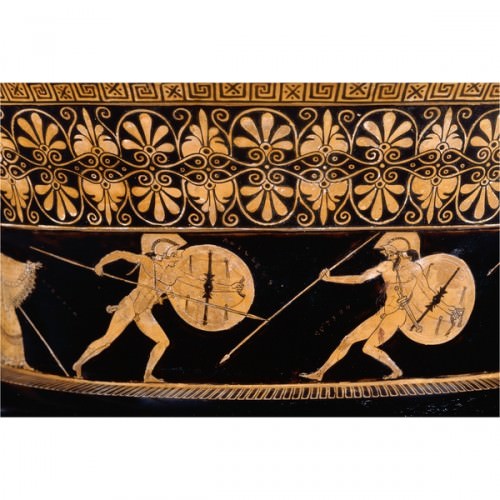
Achilles Fighting Hektor
Having avenged the death of Patroklos, Achilles arranged funeral games in his fallen friend's honour. Meanwhile, Priam entered the Greek camp in disguise and begged Achilles to return the body of his son that he might be given proper burial.Initially reluctant, the emotional pleas of the old man were finally heeded and Achilles consented to return the body. Here the Iliad ends but the war still had a few more twists of fate to turn.
THE TROJAN HORSE & VICTORY
The war involved several more exciting episodes including Achilles' fight with and killing of the Ethiopian King Memnon and the Amazon Penthesilea who both came to the aid of the Trojans. Achilles was even said to have fallen in love with the beautiful Amazon just at the moment he killed her with his spear. Achilles himself met his destiny and was killed by an arrow to his only weak spot, his ankle, shot by Paris and guided by Apollo. Odysseus and Ajax squabbled over the hero's magnificent armour and Ajax went mad with disappointment when he lost out on the prize. Slaughtering a herd of sheep he thought were Greeks, he fell on his sword in a messy and pointless suicide. Philokteles got revenge for his father, Achilles, by fatally shooting Paris with the legendary bow of Hercules. Finally, Odysseus even managed to get into the city in disguise and steal the sacred Palladion statue of Athena.
TROY WAS SACKED & THE POPULATION SLAUGHTERED OR ENSLAVED.
The final and decisive action was, though, the idea of the wooden horse. Odysseus, inspired by Athena, thought up the ruse to get a body of men inside the walls of Troy. First, the Greeks all sailed off into the sunset leaving a mysterious offering to the Trojans of a gigantic wooden horse which in reality concealed a group of warriors within. Just to make sure the Trojans took the horse within the city, Sinon was chosen to stay behind and tell a cock and bull story about the Greeks having given up and left a nice present. The Trojans did take the horse inside the city walls but whilst they were enjoying a drunken celebration of their victory, the Greeks climbed out of the horse, opened the city walls for the returning Greek army, and the city was sacked and the population slaughtered or enslaved. Helen was taken back to Argos and of the Trojan heroes only Aeneas escaped to eventually set up a new home in Italy.
Victory had its price though. Due to their pitiless ravaging of the city and its people and even worse, outrageous sacrilegious acts such as the rape of Kassandra, the gods punished the Greeks by sending storms to wreck their ships and those who did eventually return were made to endure a protracted and difficult voyage home. Even then, some of the Greeks who did make it back to their homeland only did so to face further misfortune and disaster.

The Trojan Horse
TROJAN WAR: ART & LITERATURE
Troy and the Trojan War became a staple myth of Classical Greek and Roman literature and were revisited many times by writers in works such as Aeschylus ' Agamemnon, Euripedes' Trojan Women, and Virgil ’s Aenid. Also in potterydecoration and in sculpture, artists were captivated by the Trojan War. Scenes of the judgement of Paris, Achilles fighting Hektor, Achilles playing dice with Ajax, and Ajax falling on his sword were just some of the myriad scenes from the story that would appear in art again and again over the centuries. Perhaps more importantly, the Trojan War came to represent the struggle of Greeks against foreign powers and it told tales of a time when men were better, more able, and more honourable.
TROY IN ARCHAEOLOGY
There has been much scholarly debate as to whether the mythical Troy actually existed and if so, whether the archaeological site discovered in Anatolia which revealed a city which had prospered over thousands of years of habitation was actually the same city; however, it is now almost universally accepted that the archaeological excavations have revealed the city of Homer's Iliad.
Of the several cities built on top of each other, Troy VI (c. 1750-1300 BCE) is the most likely candidate for the besieged city of Homer's Trojan War. Impressive fortification walls with several towers certainly fit the Homeric description of 'strong-built Troy'.The lower town covers an impressive 270,000 m² protected by an encircling rock-cut ditch and suggests a grand city like the Troy of tradition.
Troy VI was partially destroyed but the exact cause is not known beyond some evidence of fire. Intriguingly, bronze arrowheads, spear tips, and slingshots have been found at the site and even some embedded in the fortification walls, suggesting some sort of conflict. The dates of these (c. 1250 BCE) and the site destruction correlate with Herodotus ' dates for the Trojan War. Conflicts over the centuries between the Mycenaean and Hittite civilizations are more than probable, colonial expansion and control of lucrative trade routes being prime motivators. However, such conflicts are unlikely to have been on the scale of Homer's war, but collectively they may well have been the origin of the epic tale of the Trojan War which has fascinated for centuries.
LICENSE:
Article based on information obtained from these sources:with permission from the Website Ancient History Encyclopedia
Content is available under License Creative Commons: Attribution-NonCommercial-ShareAlike 3.0 Unported. CC-BY-NC-SA License